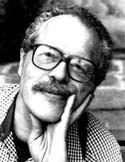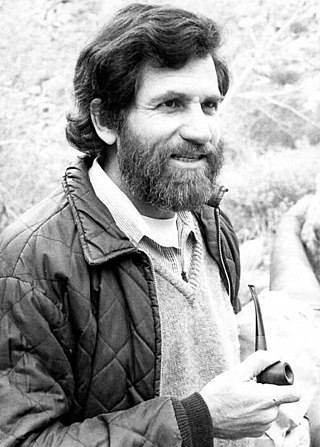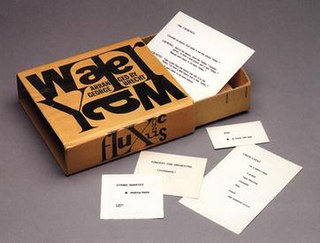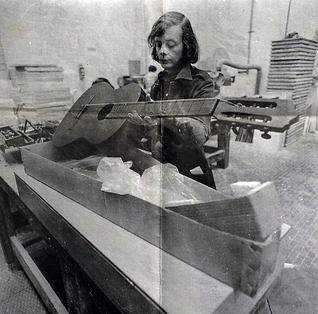
Fluxus was an international, interdisciplinary community of artists, composers, designers, and poets during the 1960s and 1970s who engaged in experimental art performances which emphasized the artistic process over the finished product. Fluxus is known for experimental contributions to different artistic media and disciplines and for generating new art forms. These art forms include intermedia, a term coined by Fluxus artist Dick Higgins; conceptual art, first developed by Henry Flynt, an artist contentiously associated with Fluxus; and video art, first pioneered by Nam June Paik and Wolf Vostell. Dutch gallerist and art critic Harry Ruhé describes Fluxus as "the most radical and experimental art movement of the sixties".
A happening is a performance, event, or situation art, usually as performance art. The term was first used by Allan Kaprow during the 1950s to describe a range of art-related events.

Dick Higgins was an American artist, composer, art theorist, poet, publisher, printmaker, and a co-founder of the Fluxus international artistic movement. Inspired by John Cage, Higgins was an early pioneer of electronic correspondence. Higgins coined the word intermedia to describe his artistic activities, defining it in a 1965 essay by the same name, published in the first number of the Something Else Newsletter. His most notable audio contributions include Danger Music scores and the Intermedia concept to describe the ineffable inter-disciplinary activities that became prevalent in the 1960s.

Alfred Earl "Al" Hansen was an American artist. He was a member of Fluxus, a movement that originated on an artists' collective around George Maciunas.

Allan Kaprow was an American performance artist, installation artist, painter, and assemblagist. He helped to develop the "Environment" and "Happening" in the late 1950s and 1960s, as well as their theory. His Happenings — some 200 of them — evolved over the years. Eventually Kaprow shifted his practice into what he called "Activities", intimately scaled pieces for one or several players, devoted to the study of normal human activity in a way congruent to ordinary life. Fluxus, performance art, and installation art were, in turn, influenced by his work.

Alison Knowles is an American visual artist known for her installations, performances, soundworks, and publications. Knowles was a founding member of the Fluxus movement, an international network of artists who aspired to merge different artistic media and disciplines. Criteria that have come to distinguish her work as an artist are the arena of performance, the indeterminacy of her event scores resulting in the deauthorization of the work, and the element of tactile participation. She graduated from Pratt Institute in New York with an honors degree in fine art. In May 2015, she was awarded an honorary doctorate degree by Pratt.

George Brecht, born George Ellis MacDiarmid, was an American conceptual artist and avant-garde composer, as well as a professional chemist who worked as a consultant for companies including Pfizer, Johnson & Johnson, and Mobil Oil. He was a key member of, and influence on, Fluxus, the international group of avant-garde artists centred on George Maciunas, having been involved with the group from the first performances in Wiesbaden 1962 until Maciunas' death in 1978.

Mason Gross School of the Arts is the arts conservatory at Rutgers University in New Brunswick, New Jersey. Mason Gross offers undergraduate and graduate degrees in art, design, dance, filmmaking, music, and theater. Mason Gross is highly selective in terms of admissions, with a low admission rate. It is named for Mason W. Gross, the sixteenth president of Rutgers.
Something Else Press was founded by Dick Higgins in 1963. It published many important Intermedia texts and artworks by such Fluxus artists as Higgins, Ray Johnson, Alison Knowles, Allan Kaprow, George Brecht, Daniel Spoerri, Robert Filliou, Al Hansen, John Cage, Emmett Williams and by such important modernist figures as Gertrude Stein, Henry Cowell, and Bern Porter.
The mid-20th-century art movement Fluxus had a strong association with Rutgers University.
Geoffrey Hendricks was an American artist associated with Fluxus since the mid 1960s. He was professor of art at Douglass College, Rutgers University, where he taught from 1956 to 2003 and was associated with Fluxus at Rutgers University, Allan Kaprow, Roy Lichtenstein, and Lucas Samaras during the 1960s.

Water Yam is an artist's book by the American artist George Brecht. Originally published in Germany, June 1963 in a box designed by George Maciunas and typeset by Tomas Schmit, it has been re-published in various countries several times since. It is now considered one of the most influential artworks released by Fluxus, the internationalist avant-garde art movement active predominantly in the 1960s and '70s. The box, sometimes referred to as a Fluxbox or Fluxkit, contains a large number of small printed cards, containing instructions known as event-scores, or fluxscores. Typically open-ended, these scores, whether performed in public, private or left to the imagination, leave a lot of space for chance and indeterminancy, forcing a large degree of interpretation upon the performers and audience.
In some cases [event-scores] would arise out of the creation of the object, while in others the object was discovered and Brecht subsequently wrote a score for it, thus highlighting the relationship between language and perception. Or, in the words of the artist, "ensuring that the details of everyday life, the random constellations of objects that surround us, stop going unnoticed." The event-score was as much a critique of conventional artistic representation as it was a gesture of firm resistance against individual alienation.

Joe Jones (1934–1993) was an American avant-garde musician associated with Fluxus, especially known for his creation of rhythmic music machines.

Robert Marshall Watts (1923–1988) was an American artist best known for his work as a member of the international group of artists Fluxus. Born in Burlington, Iowa June 14, 1923, he became Professor of Art at Douglass College, Rutgers University, New Jersey in 1953, a post he kept until 1984. In the 1950s, he was in close contact with other teachers at Rutgers including Allan Kaprow, Geoffrey Hendricks and Roy Lichtenstein. This has led some critics to claim that pop art and conceptual art began at Rutgers.
Eric Andersen is a Danish artist associated with the Fluxus art movement. He lives in Copenhagen, Denmark.

Marjorie Virginia Strider was an American painter, sculptor and performance artist best known for her three-dimensional paintings and site-specific soft sculpture installations.

Benjamin Patterson was an American musician, artist, and one of the founders of the Fluxus movement.
Mieko Shiomi is a Japanese artist, composer, and performer who played a key role in the development of Fluxus. A co-founder of the seminal postwar Japanese experimental music collective Group Ongaku, she is known for her investigations of the nature and limits of sound, music, and auditory experiences. Her work has been widely circulated as Fluxus editions, featured in concert halls, museums, galleries, and non-traditional spaces, as well as being re-performed by other musicians and artists numerous times. She is best known for her work of the 1960s and early 1970s, especially Spatial Poem, Water Music, Endless Box, and the various instructions in Events & Games, all of which were produced as Fluxus editions. Now in her eighties, she continues to produce new work.
The Smolin Gallery was an avant-garde art venue and gallery on 57th Street in New York City, at its peak in the 1960s. It was known for its involvement with installation art, performance art and experimental art, and was best known for the Allan Kaprow assemblage performance of September 11–12, 1962 entitled "Words", believed to be the first allowing the audience to participate in an art gallery context. Kaprow "used two continual rolls of cloth with words from poems, newspapers, comic and telephone books" during which the audience were asked to "tear off the words, staple them together, write notes, even attack and hack them". Verbal fragments were pasted on the walls from floor to ceiling. In April 1963, Lima and Tony Towle gave their first public recital at the gallery.

Larry Miller is an American artist, most strongly linked to the Fluxus movement after 1969. He is "an intermedia artist whose work questions the borders between artistic, scientific and theological disciplines. He was in the vanguard of using DNA and genetic technologies as new art media." Electronic Arts Intermix, a pioneering international resource for video and new media art has said, "Miller has produced a diverse body of experimental art works as a key figure in the emergent installation and performance movements in New York in the 1970s... His installations and performances have integrated diverse mediums [sic] and materials."












